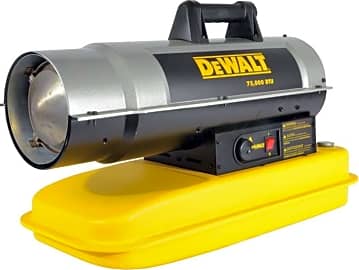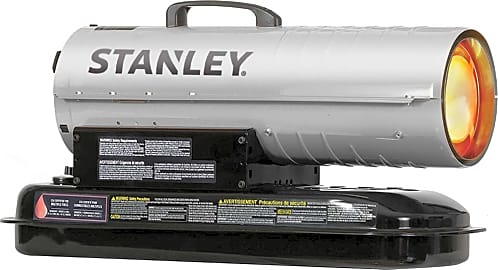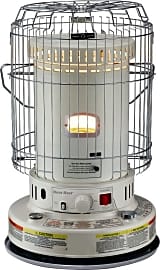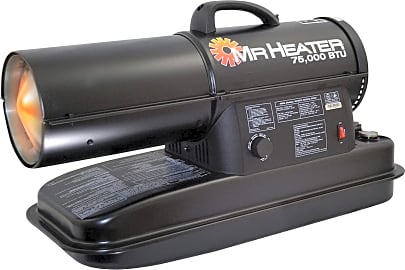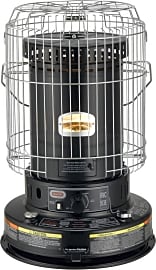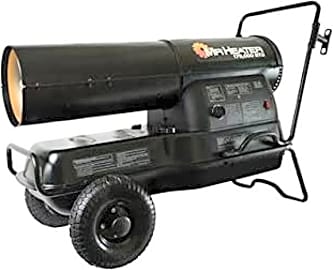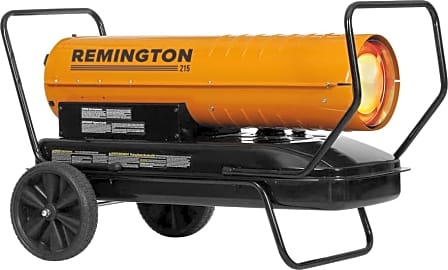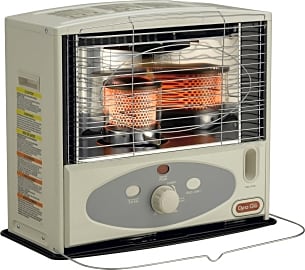The 10 Best Kerosene Heaters

This wiki has been updated 44 times since it was first published in June of 2015. If you need a portable, cost-effective solution for heating a workshop, garage, outdoor area, or room in your house, one of these kerosene heaters will take the chill off nicely. They can run for up to 12 hours on a single tank, and anybody who lives in a cold climate should keep one on hand in case of a power outage, as it might save a life. Always follow the recommended safety precautions. When users buy our independently chosen editorial recommendations, we may earn commissions to help fund the Wiki.
Editor's Notes
November 09, 2020:
Whether you're looking for a kerosene heater for a job site or for emergency use in the home, you'll find options here to select from. No matter which you opt for, though, remember to follow all safety instructions to prevent fires and carbon monoxide poisoning. In fact, if you'll be using an indoor model, you should go ahead and install a high-quality carbon monoxide detector.
With that said, the Stanley ST-80T-KFA and the Dyna Glo Delux remain strong choices for those who need the power to heat a large space. Offering up to 80,000 and 180,000 BTUs, respectively, these high-powered units will make a job site or ventilated garage a much more comfortable place to work. In case these are not powerful enough, we added the Remington 215, which is rated for up to 215,000 BTUs and can heat a space of nearly 5,500 square feet.
Smaller, in-home models to consider are led by the Dura Heat Indoor and the Dyna-Glo RMC-95C6B, which are efficient and user-friendly. Just like a good stash of survival food, having one of these around the home could help you stay comfortable in an emergency. We kept the Sengoku KeroHeat, as well, which comes in both 10,000 and 23,500 BTU versions, but we removed the Protemp Sun Stream. Although its small size is admirable, its long-term durability is suspect, especially when compared to most other models.
October 31, 2019:
There are a couple different kinds of kerosene heaters. The more common type forces large amounts of air over a powerful element using a direct blower and these are generally used outdoors or in well-ventilated garages. The Mr. Heater F270270 and Mr. Heater F270370 are two of the most popular and largest of these, though the Dyna Glo Delux may be even more effective than those two for large areas. The Stanley ST-80T-KFA and DeWalt DXH75KT are two excellent options for mid-size garages and small construction sites, and they're considerably less expensive than their larger counterparts.
Then there are smaller versions that use radiators rather than forced air. The Sengoku CTN-110 KeroHeat and Dyna-Glo RMC-55R7B are two of the best, and they're even suitable for indoor use, whereas the larger and more powerful ones listed earlier may not be ideal inside. Meanwhile, the Dura Heat DH2304 and Dyna-Glo RMC-95C6B provide 360 degrees of radiant heat, so while they're not quite as focused, their results can be more consistent and comfortable.
Whichever you choose, be absolutely certain that it's safe to use indoors if that's where you're using it, and be sure to keep flammable materials far away from it. Also remember to let it cool down completely before refilling and do not, under any circumstances, use gasoline or even an old gasoline container to refill them -- that can easily cause dangerous flareups.
If you want something that burns a little cleaner, there are quite a few freestanding propane heaters and tabletop models worth checking out as well.
Special Honors
Dyna-Glo KFA650DGD When they say that the Dyna-Glo KFA650DGD is for extreme situations, they aren't kidding. Rated for up to 650,000 BTUs, it's appropriate for big spaces in excess of 13,000 square feet, and although it's exceedingly heavy, it's on wheels that make for efficient transport. ghpgroupinc.com
What Separates a Good Kerosene Heater From a Great One?
What differentiates one model from another is how long it can last based on one tank of fuel.
The first feature you'll want to take into account whenever shopping for a kerosene heater is its BTUs (British Thermal Units). While the metrics surrounding a BTU can be a bit confusing, the thing to know is that an average kerosene heater should provide between 8,000-15,000 BTUs, whereas a superior kerosene heater might provide as many as 25,000 BTUs, or more.
A kerosene heater with high BTUs should be capable of warming a small room almost immediately. Beyond that, certain heaters boast a wider range than others. By way of example, consider that an inexpensive heater might have a range of 300 sq ft (i.e., a tiny bedroom), whereas a top-of-the-line heater might have a range of 5,000 sq ft (i.e., a full-court gym or a social hall).
Every kerosene heater needs fuel. What differentiates one model from another is how long it can last based on one tank of fuel. Most heaters can operate for 8-10 hrs after being refueled, while others can last as long as 15 hrs, or even more. This is relevant in that extra kerosene equates to extra costs, which is why you'll want to research how long a heater's power can last, along with how much fuel each model's storage can hold.
Before purchasing a heater, you'll want to take note of whether it runs on straight kerosene, or whether it also requires batteries (or outlet power). In addition, you'll want to take note of a heater's weight. Certain kerosene heaters weigh 20-30 lbs, and they feature wheels and handles for portability. Other models weigh 60-70 lbs, and they are extremely unwieldy, at best.
Several Safety Tips for Operating a Kerosene Heater
Kerosene heaters are a tremendous resource for warming a room, or even a small campsite. But the National Fire Protection Association (NFPA) warns that any kerosene heater needs to be operated with a degree of caution. There have been incidents, for example, via which people have mistakenly filled their kerosene heaters up with gasoline. This is usually the result of two or more multi-gallon containers being situated side-by-side. The best way to avoid such a mishap is by marking each of your multi-gallon containers, and color-coding each of those containers, as well.
Once the heater is at room temperature, carry it outside to avoid any indoor kerosene spills.
When it comes time to refill your kerosene heater, turn the heater off and give it several minutes to cool. Once the heater is at room temperature, carry it outside to avoid any indoor kerosene spills. Fill the heater up, and then hose the surrounding area down. Make sure to reattach any safety valves or caps before carrying the heater inside and turning it back on.
If you are operating a kerosene heater indoors, make it a point to open a window at least once a day. Kerosene heaters emit carbon monoxide and nitrogen dioxide in very minor doses, but any heater operating in an airtight atmosphere could cause these gases to accumulate. In addition, you'll want to avoid placing any papers or books within a kerosene heater's reach. Paper and cardboard aren't only flammable, they're capable of getting knocked into a heater's central core.
Finally, get in the habit of confirming that any kerosene heater has been turned off before you leave it for an extended period of time. The majority of modern heaters have been designed with built-in safety features (e.g., auto shut-off), but that doesn't change the fact that an owner's vigilance might hold the key to preventing any accidental fire.
A Brief History of Kerosene (By Way of Its Inventor)
During the 1840s, a Canadian geologist named Abraham Gesner developed a uniform process for refining fuel from coal, oil shale, or asphalt. Convinced that his fuel was cheaper and cleaner than any other fuel-oils on the market, Gesner trademarked his new product under the name "kerosene," which is based on a Greek word for wax.
Gesner returned to Nova Scotia, where he was employed as a Natural History Professor until his death in 1864.
In the mid-1850s, Gesner opened a Long Island refinery, which he called North American Kerosene Gaslight Company. Almost immediately, business skyrocketed to an extent that Gesner could scarcely keep up with the demand. Gesner responded by importing petroleum, an oil-based commodity that allowed for distilling liquid kerosene a bit quicker. Having solved the issue, Gesner shifted to writing a series of articles extolling the benefits of his product.
During the late 1850s Abraham Gesner sold North American Kerosene to a Brooklyn-based competitor named Astral Oil. Gesner returned to Nova Scotia, where he was employed as a Natural History Professor until his death in 1864.
Standard Oil absorbed North American Kerosene (along with Astral Oil) toward the end of the 1870s. Standard went on to become the largest oil company in the world - a veritable monopoly that eventually needed to be broken up by the U.S. Supreme Court. Kerosene has been slightly superseded over the past century thanks to a combination of technology, electricity, and more efficient types of fuels. Today, kerosene is still a billion-dollar industry, and yet it only accounts for .1% of all petroleum-related revenues worldwide.


